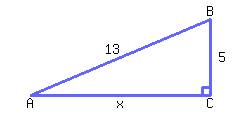Example 8.7.1 Solving Using Factoring
Solve the quadratic equations using factoring.
\(x^2-2x-15=0\)
\(4x^2-40x=-96\)
\(6x^2+x-12=0\)
\((x-3)(x+2)=14\)
\(x^3-64x=0\)
-
Use factor pairs.
\begin{align*} x^2-2x-15\amp=0\\ (x-5)(x+3)\amp=0 \end{align*}\begin{align*} x-5\amp=0 \amp\text{ or }\amp\amp x+3\amp=0\\ x\amp=5 \amp\text{ or }\amp\amp x\amp=-3 \end{align*}So the solution set is \(\{5,-3\}\text{.}\)
-
Start by putting the equation in standard form and factoring out the greatest common factor.
\begin{align*} 4x^2-40x\amp=-96\\ 4x^2-40x+96\amp=0\\ 4\left(x^2-10x+24\right)\amp=0\\ 4(x-6)(x-4)\amp=0 \end{align*}\begin{align*} x-6\amp=0 \amp\text{ or }\amp\amp x-4\amp=0\\ x\amp=6 \amp\text{ or }\amp\amp x\amp=4 \end{align*}So the solution set is \(\{4,6\}\text{.}\)
-
Use the AC method.
\begin{align*} 6x^2+x-12\amp=0\\ \end{align*}Note that \(a\cdot c=-72\) and that \(\highlight{9\cdot-8}=-72\) and \(\highlight{9-8}=1\)
\begin{align*} 6x^2\substitute{+9x-8x}-12\amp=0\\ \left(6x^2+9x\right)+\left(-8x-12\right)\amp=0\\ \highlight{3x}\left(2x+3\right)\mathbin{\highlight{-4}}\left(2x+3\right)\amp=0\\ \left(2x+3\right)\highlight{\left(3x-4\right)}\amp=0 \end{align*}\begin{align*} 2x+3\amp=0 \amp\text{ or }\amp\amp \highlight{3x-4}\amp=0\\ x\amp=-\frac{3}{2} \amp\text{ or }\amp\amp x\amp=\highlight{\frac{4}{3}} \end{align*}So the solution set is \(\left\{-\frac{3}{2},\frac{4}{3}\right\}\text{.}\)
-
Start by putting the equation in standard form.
\begin{align*} (x-3)(x+2)\amp=14\\ x^2-x-6\amp=14\\ x^2-x-20\amp=0\\ (x-5)(x+4)\amp=0 \end{align*}\begin{align*} x-5\amp=0 \amp\text{ or }\amp\amp x+4\amp=0\\ x\amp=5 \amp\text{ or }\amp\amp x\amp=-4 \end{align*}So the solution set is \(\{5,-4\}\text{.}\)
-
Even though this equation has a power higher than \(2\text{,}\) we can still find all of its solutions by following the algorithm. Start by factoring out the greatest common factor.
\begin{align*} x^3-64x\amp=0\\ x\left(x^2-64\right)\amp=0\\ x(x-8)(x+8)\amp=0 \end{align*}\begin{align*} x\amp=0 \amp\text{ or }\amp\amp x-8\amp=0 \amp\text{ or }\amp\amp x+8\amp=0\\ x\amp=0 \amp\text{ or }\amp\amp x\amp=8 \amp\text{ or }\amp\amp x\amp=-8 \end{align*}So the solution set is \(\{0,8,-8\}\text{.}\)


